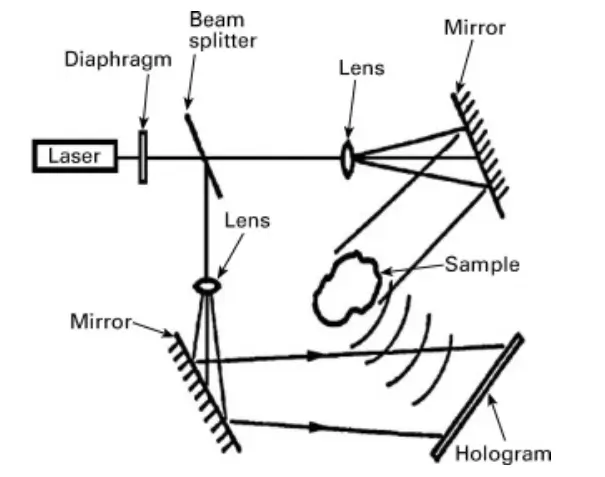Holography is a technique that allows the creation of three-dimensional images, known as holograms, using the principles of wave interference and diffraction. This innovative method has applications in various fields, including art, security, data storage, and medical imaging. To understand how holography works, it’s essential to delve into the physics underlying the process.
Fundamentals of Holography
At its core, holography relies on the interference of light waves. When two or more waves overlap, they interfere with each other, creating a pattern of constructive and destructive interference. These interference patterns can encode information about the light waves’ amplitude and phase, which are crucial for reconstructing the three-dimensional image.
Key Components and Process
1. Coherent Light Source:
- Laser: Holography requires a coherent light source, typically a laser, which emits light waves that are monochromatic (single wavelength) and in phase (coherent). This coherence is crucial for producing clear and stable interference patterns.
2. Object and Reference Beams:
- Beam Splitter: A laser beam is divided into two parts using a beam splitter: the object beam and the reference beam.
- Object Beam: This beam is directed towards the object. It illuminates the object, and the reflected light from the object carries information about its surface.
- Reference Beam: The other part of the laser beam is directed straight towards the recording medium (e.g., photographic plate, photopolymer).
3. Interference Pattern:
- When the object beam and the reference beam meet at the recording medium, they interfere, creating an interference pattern that encodes the object’s three-dimensional information.
4. Recording Medium:
- The interference pattern is captured on a high-resolution recording medium. This medium must be sensitive enough to record the fine details of the interference fringes.
Types of Holograms
- Transmission Holograms: These are viewed with light passing through them. The recorded interference pattern diffracts the light to recreate the 3D image on the other side.
- Reflection Holograms: These are viewed under reflected light. They are more complex to create but offer the advantage of being visible in white light.
- Volume Holograms: These use thick recording media where the interference pattern is recorded throughout the volume, allowing for more complex and higher-capacity data storage.
The Physics Behind Holography
Holography is a technique that allows the creation of three-dimensional images, or holograms, by recording and reconstructing the light field scattered from an object. The fundamental principles of holography were established by physicist Dennis Gabor in 1948, for which he later received the Nobel Prize in Physics in 1971. The science behind holography intertwines wave optics, interference, diffraction, and coherence, all of which contribute to the fascinating and intricate process of hologram creation and visualisation.
Basic Principles of Holography
Wave Nature of Light
Light behaves as both a particle and a wave, a duality central to many optical phenomena. Holography primarily exploits the wave nature of light, specifically its coherence and ability to interfere. Light waves are characterized by their wavelength, frequency, amplitude, and phase. When two or more light waves meet, they can interfere constructively or destructively, creating patterns that can be captured and later reconstructed.
Coherence
Coherence refers to the correlation between phases of waves at different points in space and time. For holography, two types of coherence are crucial:
- Spatial Coherence: The phase relationship between points in a light wavefront. A laser, which emits light with high spatial coherence, is often used as the light source in holography.
- Temporal Coherence: The phase relationship between points along the direction of propagation over time. It determines the ability of the light to produce a stable interference pattern over a distance.
Interference and Diffraction

Interference
Interference occurs when two coherent light waves meet, leading to a new wave pattern characterized by regions of constructive and destructive interference. This is the basis for recording a hologram.
In a typical setup:
- Reference Beam: A coherent light beam that does not interact with the object but travels directly to the recording medium.
- Object Beam: Another part of the coherent light that illuminates the object and scatters light towards the recording medium.
Diffraction
Diffraction involves the bending of light waves around obstacles and the spreading of waves when they encounter slits. When a hologram is illuminated by a reconstruction beam (usually the original reference beam or one with similar properties), the recorded interference pattern diffracts the light, reconstructing the original light wavefronts scattered by the object. This creates a three-dimensional image of the object.
Recording a Hologram
The process of recording a hologram involves the following steps:
- Preparation: A coherent light source, such as a laser, is split into two beams using a beam splitter.
- Illumination: One beam, the reference beam, is directed towards the recording medium. The other beam, the object beam, illuminates the object, and the scattered light from the object reaches the recording medium.
- Interference Pattern: The interference pattern between the reference beam and the object beam is recorded on the medium. This pattern encodes the amplitude and phase information of the light scattered by the object.
Reconstructing a Hologram
To reconstruct the hologram:
- Illumination with Reference Beam: The developed hologram is illuminated by a beam identical to the original reference beam.
- Diffraction and Reconstruction: The hologram diffracts the reference beam, reconstructing the original light waves. An observer sees a three-dimensional image of the object, with all depth cues preserved.




